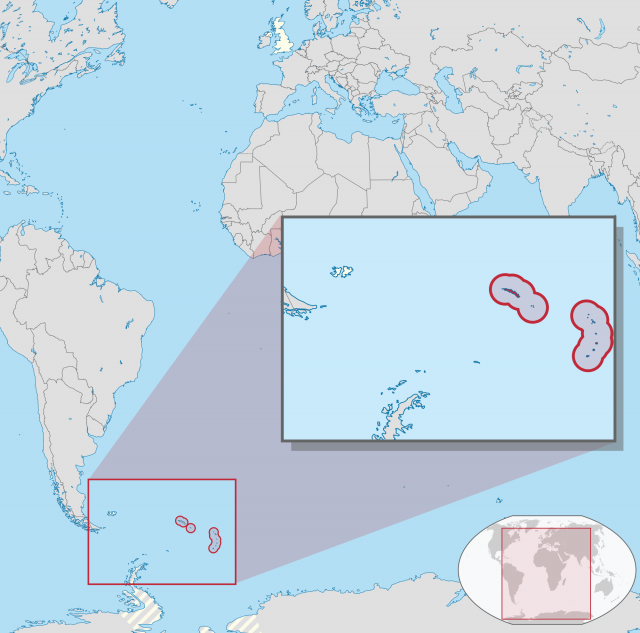South Georgia and South Sandwich Islands
SOUTH GEORGIA and the South Sandwich Islands are two island formations at the southern extremities of the ATLANTIC OCEAN, not far from the Antarctic Peninsula that juts out from ANTARCTICA, 1,000 mi (1,600 km) to the south. Mostly consisting of steep mountains and ice, they have never had an indigenous population, but are instead known for one of the most numerous and diverse bird populations on earth. The British have administered the islands since 1908, first as dependencies of the Falkland Islands about 800 mi (1,300 km) to the northwest, then as a separate territory dating from 1985. ARGENTINA continues to claim the islands, but has formally renounced intentions to regain the islands militarily.
South Georgia and the South Sandwich Islands are volcanic in origin, formed on the boundaries of two small tectonic plates, the Scotia and South Sandwich plates, as they rub against or are subducted beneath the much larger South American Plate. South Georgia consists of one main island, with smaller islands offshore (Willis, Bird, and Cooper), plus the more distant Shag Rocks, Black Rock, and Clerke Rocks. The South Sandwich Islands are a chain of 11 main islands (from north to south): Traversay, Protector Shoal, Zavodovski, Leskov, Visokoi, Candlemas, Vindication, Saunders, Montagu, Bristol, and the Thule Islands.

These islands form an arc, stretching about 240 mi (400 km), following the curve of the South Sandwich Trench, a deep trough in the Atlantic sea floor. The South Sandwich Islands are highly volcanic and geologically recent in origin: roughly 5 million years. Most of the islands consist of basalt and lava flow, with glaciers covering about 80 percent of each island. Together, South Georgia and the South Sandwich Islands form part of the Scotia Arc, which extends from the tip of South America to Antarctica (and also includes the South Shetland and South Orkney Islands, though these are not part of the British dependency).
The island of South Georgia is 105 mi (170 km) long, and about 25 mi (40 km) wide. Two mountain ranges form its spine, with 11 peaks exceeding 6,600 ft (2,000 m). The coastline of South Georgia is generally rough and mountainous, with plentiful large bays and inlets, mostly on the north coast, well suited for deepwater anchorages and whaling stations. Moraine on the floor of many of the bays, deposited by over 160 glaciers, creates a serious hazard for ships and has caused numerous wrecks. The interior is rugged and mostly covered in permanent ice and snow, with little vegetation. The South Sandwich Islands are difficult to approach by ship because of these extreme weather conditions.
DISCOVERY
Claims for first discovery of the islands are clouded in uncertainty on account of the remoteness and inhospitality of the climate in this part of the world. Different theories of discovery are put forward by supporters of British or Argentine claims over the islands.
Several explorers are cited as having spotted South Georgia's icy mountaintops in the early 18th century, but the first confirmed sighting and landing is by Captain James Cook in 1775, who named it after his sovereign, King George III. Cook also visited the Sandwich Islands (and named them for the fourth Earl of Sandwich, first lord of the Admiralty), but the first landing was not until 1818, when seal hunters visited. Shortly after reports of the island's large seal population got back to Europe, sealing expeditions set out for the South Atlantic, the start of a big business that continued for two decades until the island's seal population was nearly wiped out.
Whaling stations were established by Scandinavians in the early 20th century, the largest at Grytviken, which was abandoned in the mid-1960s, but is now being redeveloped as a museum. Grytviken was also a starting point for many 20th-century expeditions to Antarctica, including the famous doomed journey of Sir Ernest Shackleton and the crew of the Endurance. A new base was developed in the 1950s at King Edward Point, which is currently the seat of British administration, meteorological observations, and regulation of natural and commercial wildlife.
The UNITED KINGDOM extended its exclusive fishing zone in 1993 from 12 nautical mi to 200 nautical mi around each island to preserve marine stocks. Economic activity is limited to fisheries, with potential for harvesting finfish and krill. Reindeer, introduced in the 21st century, live on South Georgia. Tourism is also a recent new business, with increasing numbers of specialized cruise ships bringing tourists to view the islands' abundant wildlife: South Georgia is a vital breeding oasis for some of the greatest concentration of wildlife on the planet—at least half of the world's populations of southern fur seals, southern elephant seals, penguins, and albatrosses come here to breed each summer.